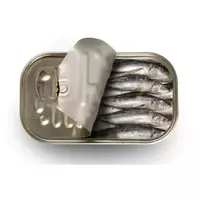Canned sardines

Humanity has perfectly mastered the process of preserving various products. We harvest vegetables, fruits and mushrooms for the winter. On the shelves of modern stores you can see the abundance of various coats, as well as meat and fish.
Canned sardines have settled for a long time among the ingredients of many dishes at our everyday and festive meals. All kinds of fish salads, snacks, fish soups and ears, as well as pates, cutlets and even pastries. Canned sardines are just a versatile product that will find its application everywhere.
When we hear the phrase canned sardines, we immediately imagine Sardine fish. Sardine marine fish, which belongs to the Seldev family, are small in size (from 15 to 25 cm maximum). Sardine lives mainly in the Atlantic Ocean and the Mediterranean Sea.
It is worth noting that Sardine is the collective name of three separate subspecies of this fish - Pilchard, Sardinops and Sardinella. It's not for nothing that we delve into the wilds of the Sardine family tree of fish. The fact is that not all canned sardines are made from real delicatessen sardines.
For example, the US fishing industry has long sinned and produces canned sardines under the inscription jars with canned young herring. In the "young" years, Sardine and Herring are similar, like two drops of water, it is not for nothing that they are assigned to the same Herring genus. Sensible American producers decided that the consumer, in principle, would not care if they were real canned sardines or herring.
The Ukrainian canning industry also makes canned sardines from hamsa or anchovy. And in European countries such as Austria and Germany, canned sardines are given small herring sprats. All these canned fish actually have nothing to do with real canned sardines apart from the name. Calm, no panic!
Not everything is as bad as it seems at first glance. If your desire is great to find real canned sardines is not a problem. Canned sardines are produced only in France. The process of making canned sardines is honed by the French and brought to automatism. Canned sardines, which are produced with olive oil, are world famous and famous.
This product is unusually popular with chefs who prepare French and fish cuisine. In addition to culinary masterpieces, delicious and simple sandwiches are made from canned sardines. Real canned sardines have the same vitamin-mineral composition as fresh fish meat.
Canned sardines contain natural and digestible protein, as well as iodine, calcium. Sardine fish is classified as quite high-calorie products, its composition contains the useful Omega-3 fatty acid, as well as vitamins A, D and C. Real canned sardines can become not only a dish for foodies or a filling for democratic sandwiches. This canned little fish can also be an incredibly healthy product.
canned sardines 166 kCal
Energy value of preserved sardines (Ratio of proteins, fats, carbohydrates - ju):
Squirrels: 19 g. (~ 76 kCal)
Fats: 10g (~ 90kCal)
Carbohydrates: 0 g (~ 0 kCal)
Energy ratio (bj | y): 46% | 54% | 0%
 Español
Español Français
Français Português
Português Русский
Русский 简体中文
简体中文 繁體中文
繁體中文 日本語
日本語 한국어
한국어 العربية
العربية Türkçe
Türkçe Қазақ
Қазақ Deutsch
Deutsch Italiano
Italiano Українська
Українська
